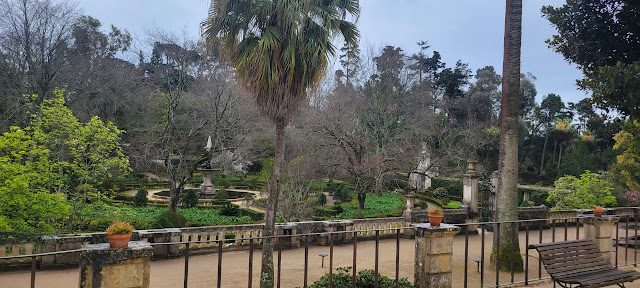Wednesday, 8 March 2023
We had breakfast in the little coffee shop that Amy had been frequenting from morning one.
Today, we have scheduled a ‘small group tour’ Aveiro & Coimbra with a River Cruise. Meeting in front of City Hall.
So, we travel for an hour and a half to the waterfront city of Coimbra, the capital of Portugal during the First Dynasty, from 1131 to 1255.
Our first stop was the botanical garden, a peaceful oasis - especially in the rain, with over 1200 species of plants from around the world.
The Roman Aqueduct was built during the reign of Emperor Augustus in the 1st century AD. The 2-mile structure was constructed to transport water to the Roman city of Aeminium, which is now modern-day Coimbra.
Moving to the University, we enter the main courtyard through The Iron Gate, a historic gate built in the 1630s and is decorated with the coat of arms of the University of Coimbra.
Dominating the courtyard is the royal palace now known as The Palace of the Schools is a magnificent building dating back to the 16th century, and converted into a university building in the 18th century.
Connected to the palace on another side of the courtyard is The Chapel of Saint Michael, known for its elaborate Baroque decoration.
In the center of the plaza, there is a statue of King Joao III, who founded the university in 1537.
Next to the Chapel is the Joanina Library, a Baroque masterpiece, recognized as one of the most beautiful libraries in the world, with stunning frescoes, gilded woodwork, and thousands of ancient books.
Tours of the Library are timed entrances every 20 minutes. The que is admitted first into the Academic Prison is a small room located in the library basement that was used to punish students who broke the university's rules.
The group is then admitted for 10 minutes to the lower library. Many old books, but not much to look at.
Finally, the group is admitted to the main Library. WOW. Photos are not permitted, but as you know, not everyone follows the rules, so this is an image from others of this amazing space.
The Library is home to several species of bats, including the Common Pipistrelle and the Greater Horseshoe Bat. The bats are believed to have been living in the library since it was first built, and they play an important role in preserving the books. Bats eat insects, including bookworms and moths, which can damage the books. The bats in the Joanina Library help to protect the collection by keeping the insect population under control.
 |
| DALL-E AI: “a bat reading a book painting like Paula Rego” |
After the university/library we headed to the historic city center for a brief shopping stroll. One of the interesting things we found were Suspiros, a big beige cracked sweet made with sugar and whisked egg whites.
Next, there is a 45 minute drive to Aveiro for lunch, some site seeing, and we a Moliceiro boat ride. Moliceiro boats are characterized by their colorful and ornate decorations, which typically feature images of historical events, popular legends, or everyday life in the region of Aveiro. The boats are relatively long and narrow, with a flat bottom and a pointed bow and stern. They are propelled by a long oar, known as a "haste," which is operated by a skilled oarsman.
We had a traditional Portuguese meal: Arroz de Marisco: ‘seafood rice.’ at O Legado da Ria.
Followed by a little walk around town before heading back to see if a boat ride is still on the schedule. It is not. The wind and rain will make a tour of the canals a bit cold. There is a backup plan: A Tuk-Tuk tour…
A Tuk Tuk tour is a type of sightseeing tour that uses a small, three-wheeled vehicle called a tuk tuk. It was moderately better than a boatride in the rain. There were plastic sides, but they needed to be zipped and unzipped to travel or to see the city.
An interesting industry in Aceiro is sea salt. The fields are flooded with seawater and the sun evaporates the water, leaving the salt to be harvested.
We also got to sample Ovos moles de Aveiro, a traditional sweet of Aveiro. It is a type of candy made from a mixture of egg yolks and sugar, which are cooked over low heat until they become thick and creamy.
The mixture is then molded into various shapes, including shells, fish, and barrels, using wooden molds, which are unique to the region. The final product is then coated with a thin layer of rice paper, giving it a slightly crunchy texture. We did not think they were that exciting.
Moving on, we headed to the Costa Nova do Prado, a historic fishing village just a few kilometers from Aveiro, famous for its colorful striped houses.
Our guide dropped us at the Livraria Lello Bookstore, one of the most beautiful bookstores in the world. It has been featured in several films, including Harry Potter and the Sorcerer's Stone. The bookstore was designed by architect Francisco Xavier Esteves and features a stunning neo-Gothic facade, stained glass windows, and a grand staircase. Due to its popularity, the bookstore charges 5€ admission (refundable with purchase). And yes, there is a line in the plaza out front.
After buying Barney a Portugese Cookbook, he proved he still has trouble reading the walking maps. Construction and road closures did not help, but we finally made it to Tapabento. Another restaurant that specializes in traditional Portuguese cuisine with a contemporary twist and is known for its delicious tapas.
Then another Uber ride home.




































No comments:
Post a Comment